Monitoring Hydrothermal Activity Using Major and Trace Elements in Low-Temperature Fumarolic Condensates: The Case of La Soufriere de Guadeloupe Volcano
Abstract
:1. Introduction
2. Geological Background
3. Sampling and Analytical Methods
4. Results
4.1. Giggenbach Bottles
4.2. Major and Trace Element Concentrations in Gas Condensate Samples
4.3. Groundwater Level Variation
4.4. Volcano–Tectonic Earthquakes
5. Discussion
5.1. Definition of Anomalous Periods
5.2. Monitoring
6. Conclusions
Supplementary Materials
Author Contributions
Funding
Data Availability Statement
Acknowledgments
Conflicts of Interest
References
- Symonds, R.B.; Gerlach, T.M.; Reed, M.H. Magmatic Gas Scrubbing: Implications for Volcano Monitoring. J. Volcanol. Geotherm. Res. 2001, 108, 303–341. [Google Scholar] [CrossRef]
- Fischer, T.; Chiodini, G. Volcanic, Magmatic and Hydrothermal Gases. In The Encyclopedia of Volcanoes; Elsevier: Amsterdam, The Netherlands, 2015; pp. 779–797. ISBN 978-0-12-385938-9. [Google Scholar]
- Giggenbach, W.F. Chemical Composition of Volcanic Gases. In Monitoring and Mitigation of Volcano Hazards; Springer: Berlin/Heidelberg, Germany, 1996; pp. 221–256. ISBN 978-3-642-80089-4. [Google Scholar]
- Moretti, R.; Stefánsson, A. Volcanic and Geothermal Redox Engines. Elements 2020, 16, 179–184. [Google Scholar] [CrossRef]
- Agusto, M.; Tassi, F.; Caselli, A.T.; Vaselli, O.; Rouwet, D.; Capaccioni, B.; Caliro, S.; Chiodini, G.; Darrah, T. Gas Geochemistry of the Magmatic-Hydrothermal Fluid Reservoir in the Copahue–Caviahue Volcanic Complex (Argentina). J. Volcanol. Geotherm. Res. 2013, 257, 44–56. [Google Scholar] [CrossRef]
- Delmelle, P.; Bernard, A.; Kusakabe, M.; Fischer, T.; Takano, B. Geochemistry of the Magmatic–Hydrothermal System of Kawah Ijen Volcano, East Java, Indonesia. J. Volcanol. Geotherm. Res. 2000, 97, 31–53. [Google Scholar] [CrossRef]
- Capaccioni, B.; Aguilera, F.; Tassi, F.; Darrah, T.; Poreda, R.J.; Vaselli, O. Geochemical and Isotopic Evidences of Magmatic Inputs in the Hydrothermal Reservoir Feeding the Fumarolic Discharges of Tacora Volcano (Northern Chile). J. Volcanol. Geotherm. Res. 2011, 208, 77–85. [Google Scholar] [CrossRef]
- Norton, D.L. Theory of Hydrothermal Systems. Annu. Rev. Earth Planet. Sci. 1984, 12, 155–177. [Google Scholar] [CrossRef]
- Cioni, R.; Marini, L. A Thermodynamic Approach to Water Geothermometry; Springer Geochemistry; Springer International Publishing: Cham, Switzerland, 2020; ISBN 978-3-030-54317-4. [Google Scholar]
- Moune, S.; Moretti, R.; Burtin, A.; Jessop, D.; Didier, T.; Robert, V.; Bonifacie, M.; Tamburello, G.; Komorowski, J.-C.; Allard, P.; et al. Gas Monitoring of Volcanic-Hydrothermal Plumes in a Tropical Environment: The Case of La Soufrière de Guadeloupe Unrest Volcano (Lesser Antilles). Front. Earth Sci. 2022, 10, 795760. [Google Scholar] [CrossRef]
- Moretti, R.; Komorowski, J.-C.; Ucciani, G.; Moune, S.; Jessop, D.; de Chabalier, J.-B.; Beauducel, F.; Bonifacie, M.; Burtin, A.; Vallée, M.; et al. The 2018 Unrest Phase at La Soufrière of Guadeloupe (French West Indies) Andesitic Volcano: Scrutiny of a Failed but Prodromal Phreatic Eruption. J. Volcanol. Geotherm. Res. 2020, 393, 106769. [Google Scholar] [CrossRef]
- Sortino, F.; Nonell, A.; Toutain, J.P.; Munoz, M.; Valladon, M.; Volpicelli, G. A New Method for Sampling Fumarolic Gases: Analysis of Major, Minor and Metallic Trace Elements with Ammonia Solutions. J. Volcanol. Geotherm. Res. 2006, 158, 244–256. [Google Scholar] [CrossRef]
- Vaselli, O.; Tassi, F.; Montegrossi, G.; Capaccioni, B.; Giannini, L. Sampling and Analysis of Volcanic Gases. Acta Vulcanol. J. Natl. Volcan. Group Italy 2006, 18, 65–76. [Google Scholar] [CrossRef]
- Giggenbach, W.F. A Simple Method for the Collection and Analysis of Volcanic Gas Samples. Bull. Volcanol. 1975, 39, 132–145. [Google Scholar] [CrossRef]
- Shinohara, H.; Ohminato, T.; Takeo, M.; Tsuji, H.; Kazahaya, R. Monitoring of Volcanic Gas Composition at Asama Volcano, Japan, during 2004–2014. J. Volcanol. Geotherm. Res. 2015, 303, 199–208. [Google Scholar] [CrossRef]
- De Moor, J.M.; Aiuppa, A.; Pacheco, J.; Avard, G.; Kern, C.; Liuzzo, M.; Martínez, M.; Giudice, G.; Fischer, T. Short-Period Volcanic Gas Precursors to Phreatic Eruptions: Insights from Poás Volcano, Costa Rica. Earth Planet. Sci. Lett. 2016, 442, 218–227. [Google Scholar] [CrossRef] [Green Version]
- Taran, Y.; Gavilanes, J.C.; Cortés, A. Chemical and Isotopic Composition of Fumarolic Gases and the SO2 Flux from Volcán de Colima, México, between the 1994 and 1998 Eruptions. J. Volcanol. Geotherm. Res. 2002, 117, 105–119. [Google Scholar] [CrossRef]
- Caliro, S.; Chiodini, G.; Moretti, R.; Avino, R.; Granieri, D.; Russo, M.; Fiebig, J. The Origin of the Fumaroles of La Solfatara (Campi Flegrei, South Italy). Geochim. Cosmochim. Acta 2007, 71, 3040–3055. [Google Scholar] [CrossRef]
- Zimmer, M.; Walter, T.R.; Kujawa, C.; Gaete, A.; Franco-Marin, L. Thermal and Gas Dynamic Investigations at Lastarria Volcano, Northern Chile. The Influence of Precipitation and Atmospheric Pressure on the Fumarole Temperature and the Gas Velocity. J. Volcanol. Geotherm. Res. 2017, 346, 134–140. [Google Scholar] [CrossRef]
- de Bremond d’Ars, J.; Gibert, D. Low-Temperature Hydrothermal Systems Response to Rainfall Forcing: An Example From Temperature Time Series of Fumaroles at La Soufrière de Guadeloupe Volcano. Front. Earth Sci. 2022, 9, 772176. [Google Scholar] [CrossRef]
- Gibert, D.; Bremond d’Ars, J.; Carlus, B.; Deroussi, S.; Ianigro, J.; Jessop, D.E.; Jourde, K.; Kergosien, B.; Le Gonidec, Y.; Lesparre, N.; et al. Observation of the Dynamics of Hydrothermal Activity in La Soufrière of Guadeloupe Volcano with Joint Muography, Gravimetry, Electrical Resistivity Tomography, Seismic and Temperature Monitoring. In Geophysical Monograph Series; Oláh, L., Tanaka, H.K.M., Varga, D., Eds.; Wiley: Hoboken, NJ, USA, 2022; pp. 55–73. ISBN 978-1-119-72302-8. [Google Scholar]
- Moretti, R.; Troise, C.; Sarno, F.; De Natale, G. Caldera Unrest Driven by CO2-Induced Drying of the Deep Hydrothermal System. Sci. Rep. 2018, 8, 8309. [Google Scholar] [CrossRef]
- Moretti, R.; Natale, G.D.; Troise, C. Hydrothermal versus Magmatic. In Vesuvius, Campi Flegrei, and Campanian Volcanism; Elsevier: Amsterdam, The Netherlands, 2020; pp. 371–406. ISBN 978-0-12-816454-9. [Google Scholar]
- Rodríguez, A.; Eggenkamp, H.G.M.; Martínez-Cruz, M.; van Bergen, M.J. Chlorine Isotope and Cl–Br Fractionation in Fluids of Poás Volcano (Costa Rica): Insight into an Active Volcanic–Hydrothermal System. J. Volcanol. Geotherm. Res. 2016, 325, 70–85. [Google Scholar] [CrossRef]
- Menard, G.; Moune, S.; Vlastélic, I.; Aguilera, F.; Valade, S.; Bontemps, M.; González, R. Gas and Aerosol Emissions from Lascar Volcano (Northern Chile): Insights into the Origin of Gases and Their Links with the Volcanic Activity. J. Volcanol. Geotherm. Res. 2014, 287, 51–67. [Google Scholar] [CrossRef]
- Keizer, M.J. Origin and Significance of Mobile Trace Elements in Volcanic Lakes—A Case Study at Poás, Costa Rica. Master Thesis, Universiteit Utrecht, Utrecht, The Netherlands, 2015. [Google Scholar]
- Christenson, B.W.; Reyes, A.G.; Young, R.; Moebis, A.; Sherburn, S.; Cole-Baker, J.; Britten, K. Cyclic Processes and Factors Leading to Phreatic Eruption Events: Insights from the 25 September 2007 Eruption through Ruapehu Crater Lake, New Zealand. J. Volcanol. Geotherm. Res. 2010, 191, 15–32. [Google Scholar] [CrossRef]
- Mannen, K.; Abe, Y.; Daita, Y.; Doke, R.; Harada, M.; Kikugawa, G.; Honma, N.; Miyashita, Y.; Yukutake, Y. Volcanic Unrest at Hakone Volcano after the 2015 Phreatic Eruption: Reactivation of a Ruptured Hydrothermal System? Earth Planets Space 2021, 73, 80. [Google Scholar] [CrossRef]
- Mather, T.A.; Witt, M.L.I.; Pyle, D.M.; Quayle, B.M.; Aiuppa, A.; Bagnato, E.; Martin, R.S.; Sims, K.W.W.; Edmonds, M.; Sutton, A.J.; et al. Halogens and Trace Metal Emissions from the Ongoing 2008 Summit Eruption of Kīlauea Volcano, Hawai’i. Geochim. Cosmochim. Acta 2012, 83, 292–323. [Google Scholar] [CrossRef]
- Gauthier, P.-J.; Sigmarsson, O.; Gouhier, M.; Haddadi, B.; Moune, S. Elevated Gas Flux and Trace Metal Degassing from the 2014–2015 Fissure Eruption at the Bárðarbunga Volcanic System, Iceland: Degassing at Holuhraun. J. Geophys. Res. Solid Earth 2016, 121, 1610–1630. [Google Scholar] [CrossRef] [Green Version]
- Allard, P.; Aiuppa, A.; Bani, P.; Métrich, N.; Bertagnini, A.; Gauthier, P.-J.; Shinohara, H.; Sawyer, G.; Parello, F.; Bagnato, E.; et al. Prodigious Emission Rates and Magma Degassing Budget of Major, Trace and Radioactive Volatile Species from Ambrym Basaltic Volcano, Vanuatu Island Arc. J. Volcanol. Geotherm. Res. 2016, 322, 119–143. [Google Scholar] [CrossRef]
- Symonds, R.B.; Rose, W.I.; Gerlach, T.M.; Briggs, P.H.; Harmon, R.S. Evaluation of Gases, Condensates, and SO2 Emissions from Augustine Volcano, Alaska: The Degassing of a Cl-Rich Volcanic System. Bull. Volcanol. 1990, 52, 355–374. [Google Scholar] [CrossRef]
- Symonds, R.B.; Mizutani, Y.; Briggs, P.H. Long-Term Geochemical Surveillance of Fumaroles at Showa-Shinzan Dome, Usu Volcano, Japan. J. Volcanol. Geotherm. Res. 1996, 73, 177–211. [Google Scholar] [CrossRef]
- Africano, F.; Bernard, A. Acid Alteration in the Fumarolic Environment of Usu Volcano, Hokkaido, Japan. J. Volcanol. Geotherm. Res. 2000, 97, 475–495. [Google Scholar] [CrossRef]
- Moune, S.; Gauthier, P.-J.; Delmelle, P. Trace Elements in the Particulate Phase of the Plume of Masaya Volcano, Nicaragua. J. Volcanol. Geotherm. Res. 2010, 193, 232–244. [Google Scholar] [CrossRef]
- Heinrich, C.A.; Günther, D.; Audétat, A.; Ulrich, T.; Frischknecht, R. Metal Fractionation between Magmatic Brine and Vapor, Determined by Microanalysis of Fluid Inclusions. Geology 1999, 27, 755. [Google Scholar] [CrossRef]
- Mandon, C.L.; Christenson, B.W.; Schipper, C.I.; Seward, T.M.; Garaebiti, E. Metal Transport in Volcanic Plumes: A Case Study at White Island and Yasur Volcanoes. J. Volcanol. Geotherm. Res. 2019, 369, 155–171. [Google Scholar] [CrossRef]
- Zelenski, M.; Kamenetsky, V.S.; Taran, Y.; Kovalskii, A.M. Mineralogy and Origin of Aerosol From an Arc Basaltic Eruption: Case Study of Tolbachik Volcano, Kamchatka. Geochem. Geophys. Geosystems 2020, 21, 1–30. [Google Scholar] [CrossRef]
- Zelenski, M.; Malik, N.; Taran, Y. Emissions of Trace Elements during the 2012–2013 Effusive Eruption of Tolbachik Volcano, Kamchatka: Enrichment Factors, Partition Coefficients and Aerosol Contribution. J. Volcanol. Geotherm. Res. 2014, 285, 136–149. [Google Scholar] [CrossRef]
- Barbieri, M.; Franchini, S.; Barberio, M.D.; Billi, A.; Boschetti, T.; Giansante, L.; Gori, F.; Jónsson, S.; Petitta, M.; Skelton, A.; et al. Changes in Groundwater Trace Element Concentrations before Seismic and Volcanic Activities in Iceland during 2010–2018. Sci. Total Environ. 2021, 793, 148635. [Google Scholar] [CrossRef] [PubMed]
- Villemant, B.; Hammouya, G.; Michel, A.; Semet, M.P.; Komorowski, J.-C.; Boudon, G.; Cheminée, J.-L. The Memory of Volcanic Waters: Shallow Magma Degassing Revealed by Halogen Monitoring in Thermal Springs of La Soufrière Volcano (Guadeloupe, Lesser Antilles). Earth Planet. Sci. Lett. 2005, 237, 710–728. [Google Scholar] [CrossRef]
- Villemant, B.; Komorowski, J.-C.; Dessert, C.; Michel, A.; Crispi, O.; Hammouya, G.; Beauducel, F.; De Chabalier, J.B. Evidence for a New Shallow Magma Intrusion at La Soufrière of Guadeloupe (Lesser Antilles). J. Volcanol. Geotherm. Res. 2014, 285, 247–277. [Google Scholar] [CrossRef] [Green Version]
- Aiuppa, A.; Fischer, T.; Plank, T.; Robidoux, P.; Di Napoli, R. Along-Arc, Inter-Arc and Arc-to-Arc Variations in Volcanic Gas CO2/ST Ratios Reveal Dual Source of Carbon in Arc Volcanism. Earth-Sci. Rev. 2017, 168, 24–47. [Google Scholar] [CrossRef]
- Feuillard, M.; Allegre, C.J.; Brandeis, G.; Gaulon, R.; Le Mouel, J.L.; Mercier, J.C.; Pozzi, J.P.; Semet, M.P. The 1975–1977 Crisis of La Soufriere de Guadeloupe (F.W.I): A Still-Born Magmatic Eruption. J. Volcanol. Geotherm. Res. 1983, 16, 317–334. [Google Scholar] [CrossRef]
- Komorowski, J.-C.; Boudon, G.; Semet, M.P.; Beauducel, F. Volcanic Hazard Atlas of the Lesser Antilles: Guadeloupe. In Volcanic Hazard Atlas of the Lesser Antilles; University of the West Indies, Seismic Research Unit: Tunapuna, Trinidad and Tobago, 2005. [Google Scholar]
- Komorowski, J.-C.; Legendre, Y.; Caron, B.; Boudon, G. Reconstruction and Analysis of Sub-Plinian Tephra Dispersal during the 1530 A.D. Soufrière (Guadeloupe) Eruption: Implications for Scenario Definition and Hazards Assessment. J. Volcanol. Geotherm. Res. 2008, 178, 491–515. [Google Scholar] [CrossRef]
- Legendre, Y. Reconstruction de L’histoire Eruptive et Scenarii Eruptifs à La Soufrière de Guadeloupe: Vers un Modèle Intégrale de Fonctionnement du Volcan. (French) A High Resolution Reconstruction of the Eruptive Past and Definition of Eruptive Scenario at La Soufrière of Guadeloupe. Ph.D. Thesis, Université Paris 7, Paris, France, 2012. [Google Scholar]
- Metcalfe, A.; Moune, S.; Komorowski, J.-C.; Kilgour, G.; Jessop, D.; Moretti, R.; Legendre, Y. Magmatic Processes at La Soufrière de Guadeloupe: Insights From Crystal Studies and Diffusion Timescales for Eruption Onset. Front. Earth Sci. 2021, 9, 617294. [Google Scholar] [CrossRef]
- Chenet, M.; Grancher, D.; Redon, M. Main Issues of an Evacuation in Case of Volcanic Crisis: Social Stakes in Guadeloupe (Lesser Antilles Arc). Nat. Hazards 2014, 73, 2127–2147. [Google Scholar] [CrossRef]
- Brombach, T.; Marini, L.; Hunziker, J.C. Geochemistry of the Thermal Springs and Fumaroles of Basse-Terre Island, Guadeloupe, Lesser Antilles. Bull. Volcanol. 2000, 61, 477–490. [Google Scholar] [CrossRef]
- Allard, P.; Aiuppa, A.; Beauducel, F.; Gaudin, D.; Di Napoli, R.; Calabrese, S.; Parello, F.; Crispi, O.; Hammouya, G.; Tamburello, G. Steam and Gas Emission Rate from La Soufriere Volcano, Guadeloupe (Lesser Antilles): Implications for the Magmatic Supply during Degassing Unrest. Chem. Geol. 2014, 384, 76–93. [Google Scholar] [CrossRef]
- Rosas-Carbajal, M.; Komorowski, J.-C.; Nicollin, F.; Gibert, D. Volcano Electrical Tomography Unveils Edifice Collapse Hazard Linked to Hydrothermal System Structure and Dynamics. Sci. Rep. 2016, 6, 29899. [Google Scholar] [CrossRef] [PubMed] [Green Version]
- Tamburello, G.; Moune, S.; Allard, P.; Venugopal, S.; Robert, V.; Rosas-Carbajal, M.; Deroussi, S.; Kitou, T.; Didier, T.; Komorowski, J.-C.; et al. Spatio-Temporal Relationships between Fumarolic Activity, Hydrothermal Fluid Circulation and Geophysical Signals at an Arc Volcano in Degassing Unrest: La Soufrière of Guadeloupe (French West Indies). Geosciences 2019, 9, 480. [Google Scholar] [CrossRef] [Green Version]
- Jessop, D.; Moune, S.; Moretti, R.; Gibert, D.; Komorowski, J.-C.; Robert, V.; Heap, M.J.; Bosson, A.; Bonifacie, M.; Deroussi, S.; et al. A Multi-Decadal View of the Heat and Mass Budget of a Volcano in Unrest: La Soufrière de Guadeloupe (French West Indies). Bull. Volcanol. 2021, 83, 16. [Google Scholar] [CrossRef]
- Moretti, R.; Moune, S.; Jessop, D.; Glynn, C.; Robert, V.; Deroussi, S. The Basse-Terre Island of Guadeloupe (Eastern Caribbean, France) and Its Volcanic-Hydrothermal Geodiversity: A Case Study of Challenges, Perspectives, and New Paradigms for Resilience and Sustainability on Volcanic Islands. Geosciences 2021, 11, 454. [Google Scholar] [CrossRef]
- Bulletins of the OVSG-IPGP. Monthly Report on the Volcanic Activity of La Soufriere de Guadeloupe and on the Regional Seismicity; OVSG-IPGP: Guadeloupe, France, 1999–2022; Available online: https://www.ipgp.fr/fr/ovsg/bulletins-mensuels-de-lovsg (accessed on 2 June 2022).
- Bulletins of the OVSG-IPGP. Monthly Report on the Volcanic Activity of La Soufriere de Guadeloupe and on the Regional Seismicity; OVSG-IPGP: Guadeloupe, France, October 2021; p. 12. Available online: http://volcano.ipgp.fr/guadeloupe/Bulletins/2021/OVSG_2021-10_fra.pdf (accessed on 2 June 2022).
- Giggenbach, W.F.; Gougel, R.L. Collection and Analysis of Geothermal and Volcanic Water and Gas Discharges, New Zealand; Institute of Geological and Nuclear Science: Lower Hutt, New Zealand, 1989. [Google Scholar]
- Moretti, R.; Moune, S.; Robert, V.; Jessop, D.; Didier, T.; Bonifacie, M.; Komorowski, J.-C. Intercomparison of Geochemical Techniques at La Soufrière de Guadeloupe (FWI) Volcano: Their Advantages and Their Limits over a Long-Standing Unrest. Ital. J. Geosci. 2020, 139, 398–412. [Google Scholar] [CrossRef]
- Inostroza, M.; Moune, S.; Moretti, R.; Bonifacie, M.; Robert, V.; Burtin, A.; Chilin-Eusebe, E. Decoding Water-Rock Interaction and Volatile Input at La Soufriere Volcano (Guadeloupe) Using Time-Series Major and Trace Element Analyses in Gas Condensates. J. Volcanol. Geotherm. Res. 2022, 425, 107517. [Google Scholar] [CrossRef]
- Chevrier, R.M.; Guern, F. Prélèvement et analyses des condensats de fumerolles sur volcans actifs: Soufrière de la Guadeloupe (1976–1977) et Pouzzoles et Vulcano (Italie) (1978). Bull. Volcanol. 1982, 45, 173–178. [Google Scholar] [CrossRef]
- Akasaka, C.; Nakanishi, S. Correction of Background Gravity Changes Due to Precipitation: Oguni Geothermal Field, Japan. In Proceedings of the World Geothermal Congress, Tohoku, Japan, 10 June 2000; pp. 2471–2475. [Google Scholar]
- Delayre, C.; Mas, P.P.; Sardini, P.; Cosenza, P.; Thomas, A. Quantitative Evolution of the Petrophysical Properties of Andesites Affected by Argillic Alteration in the Hydrothermal System of Petite Anse-Diamant, Martinique. J. Volcanol. Geotherm. Res. 2020, 401, 106927. [Google Scholar] [CrossRef]
- Salaün, A.; Villemant, B.; Gérard, M.; Komorowski, J.-C.; Michel, A. Hydrothermal Alteration in Andesitic Volcanoes: Trace Element Redistribution in Active and Ancient Hydrothermal Systems of Guadeloupe (Lesser Antilles). J. Geochem. Explor. 2011, 111, 59–83. [Google Scholar] [CrossRef]
- Gemmell, J.B. Geochemistry of Metallic Trace Elements in Fumarolic Condensates from Nicaraguan and Costa Rican Volcanoes. J. Volcanol. Geotherm. Res. 1987, 33, 161–181. [Google Scholar] [CrossRef]
- Heap, M.J.; Baumann, T.S.; Rosas-Carbajal, M.; Komorowski, J.-C.; Gilg, H.A.; Villeneuve, M.; Moretti, R.; Baud, P.; Carbillet, L.; Harnett, C.; et al. Alteration-Induced Volcano Instability at La Soufrière de Guadeloupe (Eastern Caribbean). J. Geophys. Res. Solid Earth 2021, 126, e2021JB022514. [Google Scholar] [CrossRef]
- Heap, M.J.; Jessop, D.; Wadsworth, F.B.; Rosas-Carbajal, M.; Komorowski, J.-C.; Gilg, H.A.; Aron, N.; Buscetti, M.; Gential, L.; Goupil, M.; et al. The Thermal Properties of Hydrothermally Altered Andesites from La Soufrière de Guadeloupe (Eastern Caribbean). J. Volcanol. Geotherm. Res. 2022, 421, 107444. [Google Scholar] [CrossRef]
- Nishi, Y.; Sherburn, S.; Scott, B.J.; Sugihara, M. High-Frequency Earthquakes at White Island Volcano, New Zealand: Insights into the Shallow Structure of a Volcano-Hydrothermal System. J. Volcanol. Geotherm. Res. 1996, 72, 183–197. [Google Scholar] [CrossRef]
- Triastuty, H.; Iguchi, M.; Tameguri, T. Temporal Change of Characteristics of Shallow Volcano-Tectonic Earthquakes Associated with Increase in Volcanic Activity at Kuchinoerabujima Volcano, Japan. J. Volcanol. Geotherm. Res. 2009, 187, 1–12. [Google Scholar] [CrossRef]
- Bulletins of the OVSG-IPGP. Monthly Report on the Volcanic Activity of La Soufriere de Guadeloupe and on the Regional Seismicity; OVSG-IPGP: Guadeloupe, France, January 2021; p. 11. Available online: http://volcano.ipgp.fr/guadeloupe/Bulletins/2021/OVSG_2021-01_eng.pdf (accessed on 2 June 2022).
- Inostroza, M.; Aguilera, F.; Menzies, A.; Layana, S.; González, C.; Ureta, G.; Sepúlveda, J.; Scheller, S.; Böehm, S.; Barraza, M.; et al. Deposition of Metals and Metalloids in the Fumarolic Fields of Guallatiri and Lastarria Volcanoes, Northern Chile. J. Volcanol. Geotherm. Res. 2020, 393, 106803. [Google Scholar] [CrossRef]
- Edmonds, M.; Mather, T.A.; Liu, E.J. A Distinct Metal Fingerprint in Arc Volcanic Emissions. Nat. Geosci. 2018, 11, 790–794. [Google Scholar] [CrossRef] [Green Version]
- Chiodini, G. CO2/CH4 Ratio in Fumaroles a Powerful Tool to Detect Magma Degassing Episodes at Quiescent Volcanoes. Geophys. Res. Lett. 2009, 36. [Google Scholar] [CrossRef]
- Rodríguez, A.; van Bergen, M.J.; Eggenkamp, H.G.M. Experimental Evaporation of Hyperacid Brines: Effects on Chemical Composition and Chlorine Isotope Fractionation. Geochim. Cosmochim. Acta 2018, 222, 467–484. [Google Scholar] [CrossRef] [Green Version]
- Boudon, G.; Villemant, B.; Komorowski, J.-C.; Ildefonse, P.; Semet, M.P. The Hydrothermal System at Soufriere Hills Volcano, Montserrat (West Indies): Characterization and Role in the on-Going Eruption. Geophys. Res. Lett. 1998, 25, 3693–3696. [Google Scholar] [CrossRef]
- Komorowski, J.-C.; Legendre, Y.; Christopher, T.; Bernstein, M.; Stewart, R.; Joseph, E.; Fournier, N.; Chardot, L.; Finizola, A.; Wadge, G.; et al. Insights into Processes and Deposits of Hazardous Vulcanian Explosions at Soufrière Hills Volcano during 2008 and 2009 (Montserrat, West Indies). Geophys. Res. Lett. 2010, 37. [Google Scholar] [CrossRef] [Green Version]
- Scher, S.; Williams-Jones, A.E.; Williams-Jones, G. Fumarolic Activity, Acid-Sulfate Alteration, and High Sulfidation Epithermal Precious Metal Mineralization in the Crater of Kawah Ijen Volcano, Java, Indonesia. Econ. Geol. 2013, 108, 1099–1118. [Google Scholar] [CrossRef] [Green Version]
- Chen, J.-B.; Gaillardet, J.; Dessert, C.; Villemant, B.; Louvat, P.; Crispi, O.; Birck, J.-L.; Wang, Y.-N. Zn Isotope Compositions of the Thermal Spring Waters of La Soufrière Volcano, Guadeloupe Island. Geochim. Cosmochim. Acta 2014, 127, 67–82. [Google Scholar] [CrossRef]
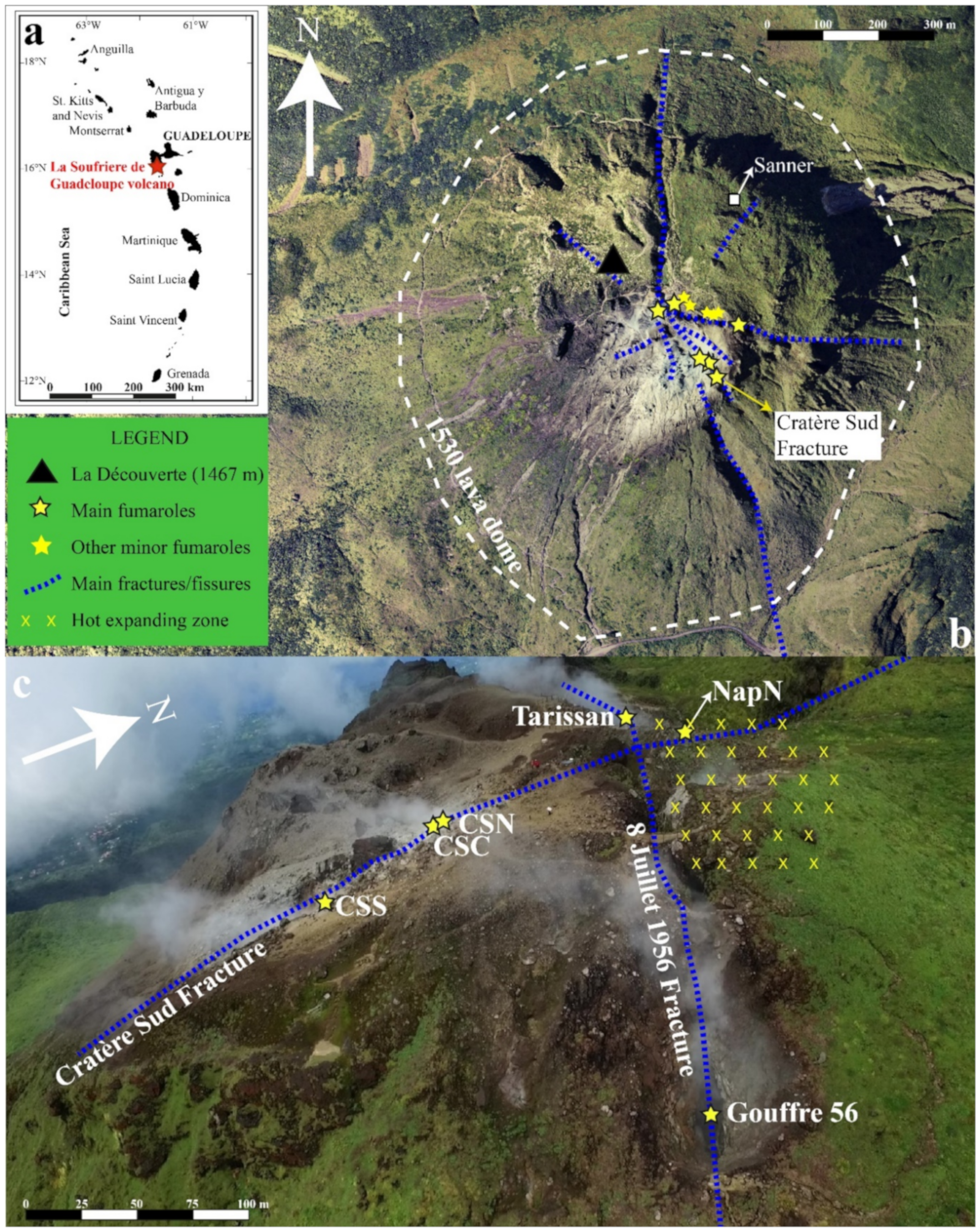
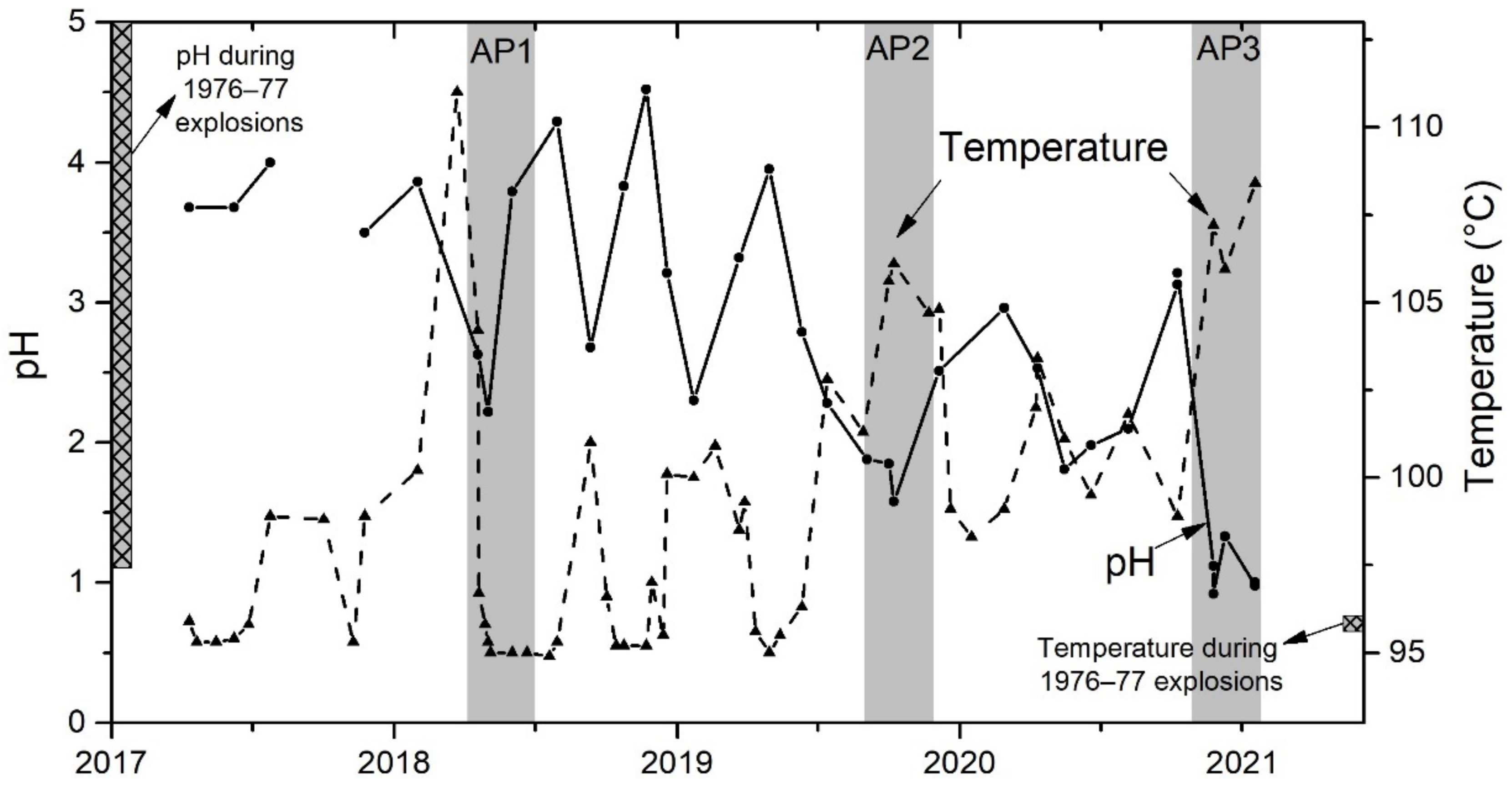

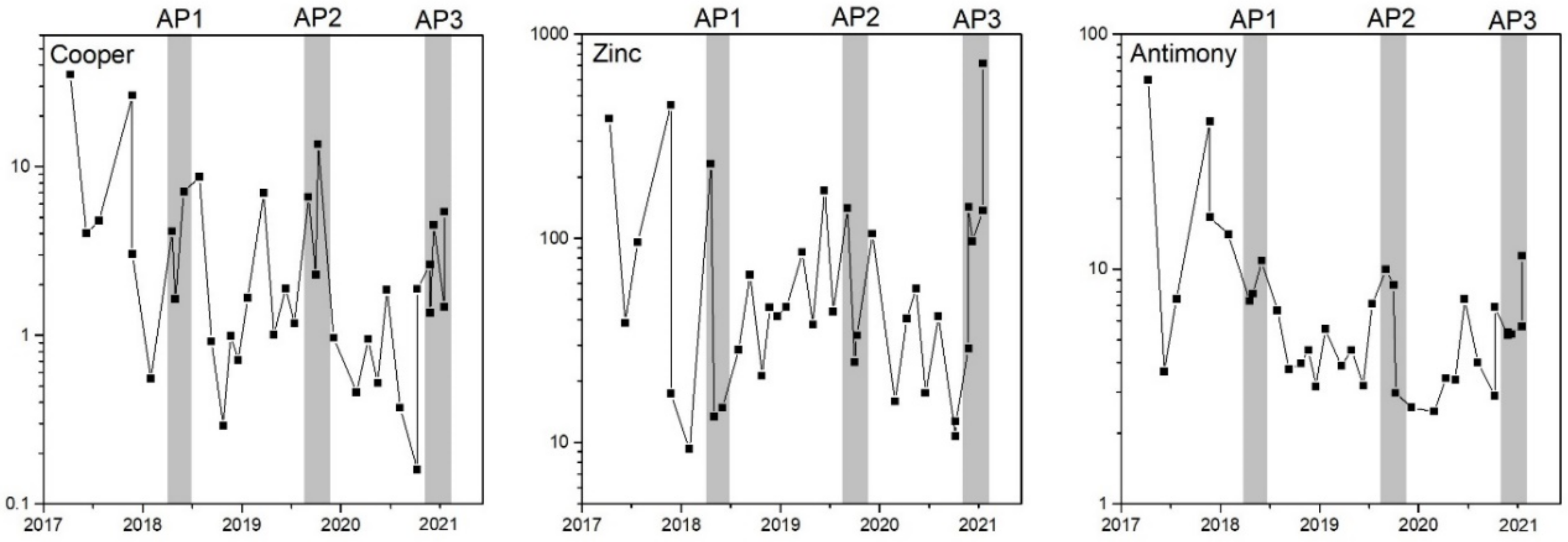
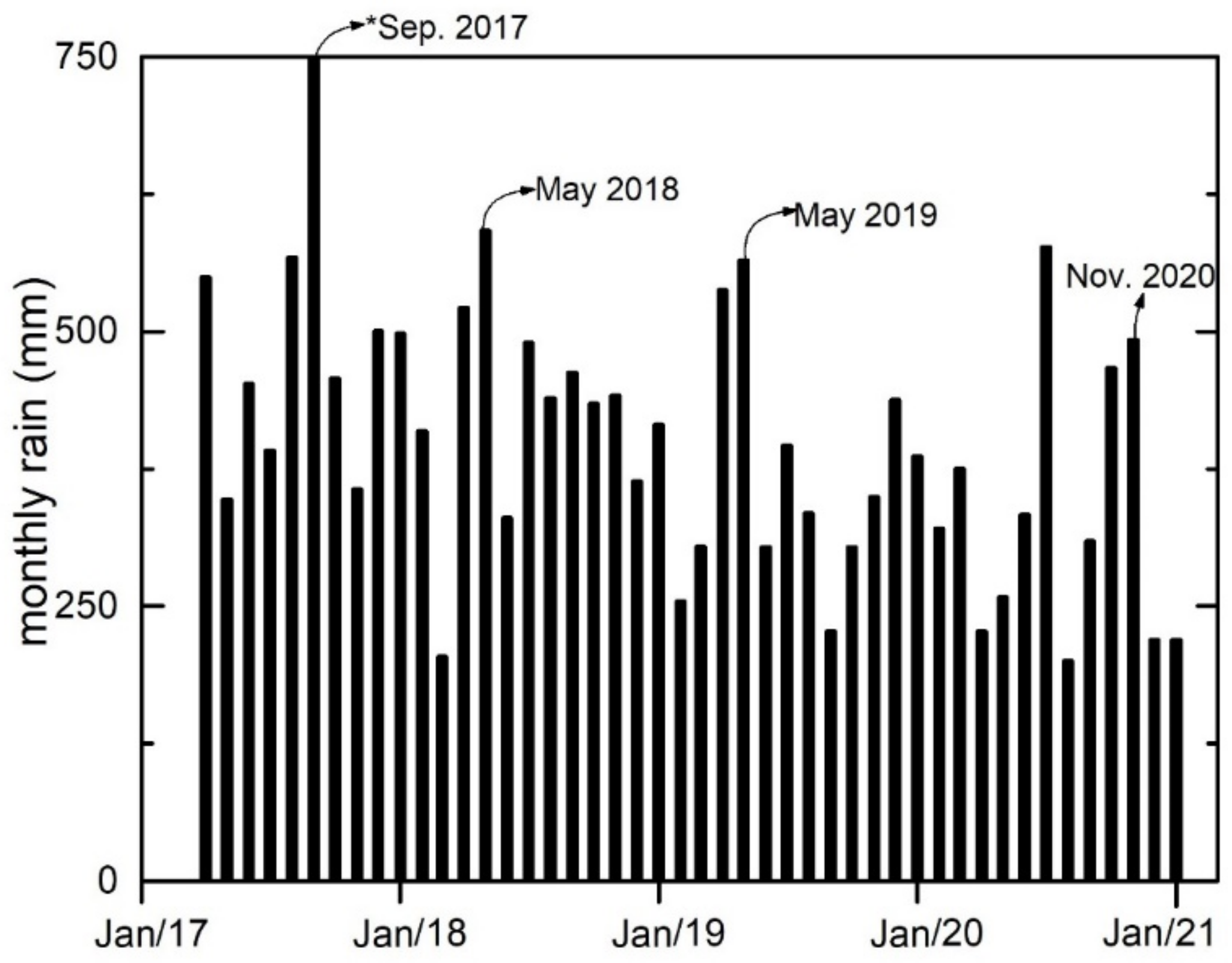
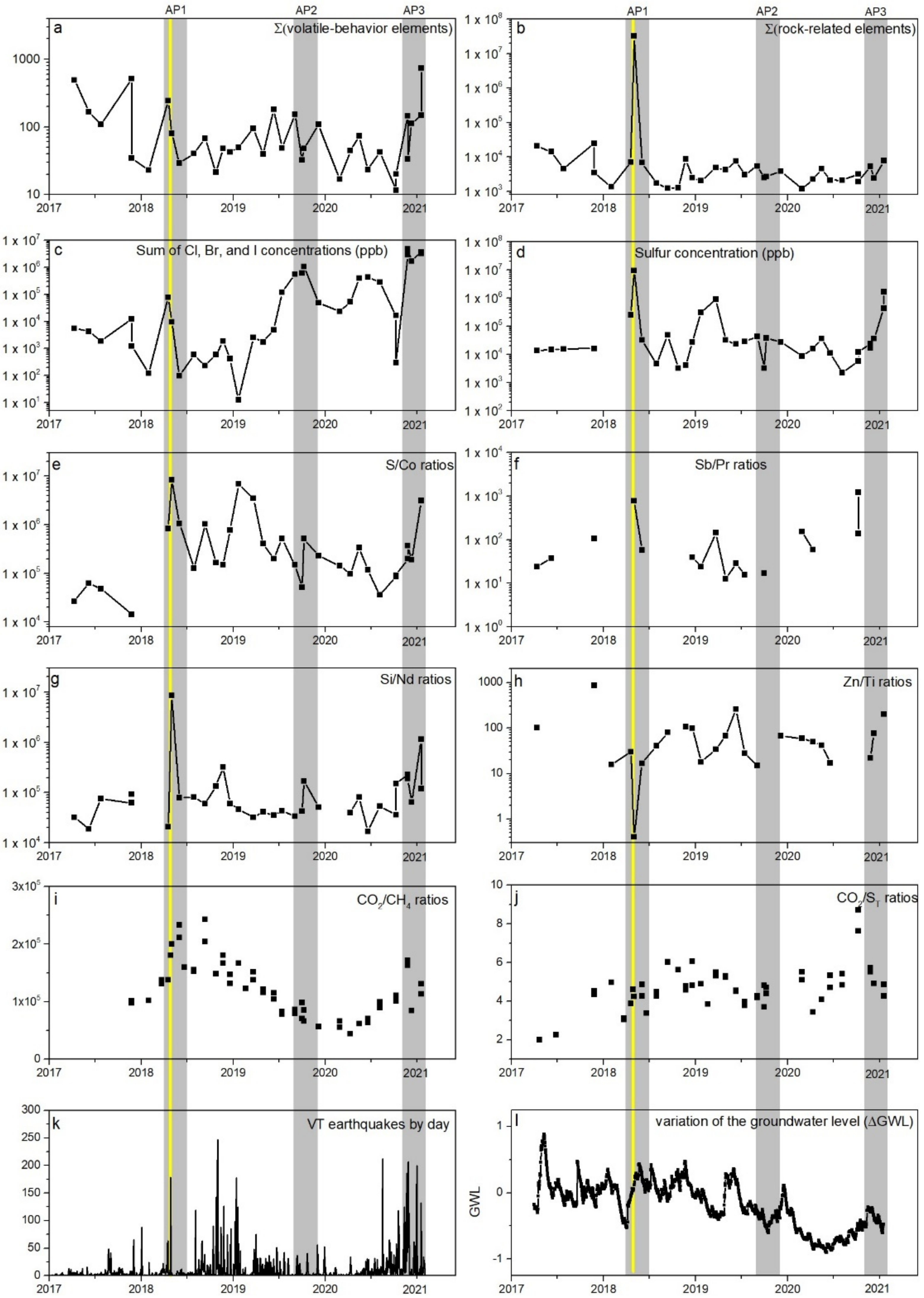

Publisher’s Note: MDPI stays neutral with regard to jurisdictional claims in published maps and institutional affiliations. |
© 2022 by the authors. Licensee MDPI, Basel, Switzerland. This article is an open access article distributed under the terms and conditions of the Creative Commons Attribution (CC BY) license (https://creativecommons.org/licenses/by/4.0/).
Share and Cite
Inostroza, M.; Moune, S.; Moretti, R.; Robert, V.; Bonifacie, M.; Chilin-Eusebe, E.; Burtin, A.; Burckel, P. Monitoring Hydrothermal Activity Using Major and Trace Elements in Low-Temperature Fumarolic Condensates: The Case of La Soufriere de Guadeloupe Volcano. Geosciences 2022, 12, 267. https://doi.org/10.3390/geosciences12070267
Inostroza M, Moune S, Moretti R, Robert V, Bonifacie M, Chilin-Eusebe E, Burtin A, Burckel P. Monitoring Hydrothermal Activity Using Major and Trace Elements in Low-Temperature Fumarolic Condensates: The Case of La Soufriere de Guadeloupe Volcano. Geosciences. 2022; 12(7):267. https://doi.org/10.3390/geosciences12070267
Chicago/Turabian StyleInostroza, Manuel, Séverine Moune, Roberto Moretti, Vincent Robert, Magali Bonifacie, Elodie Chilin-Eusebe, Arnaud Burtin, and Pierre Burckel. 2022. "Monitoring Hydrothermal Activity Using Major and Trace Elements in Low-Temperature Fumarolic Condensates: The Case of La Soufriere de Guadeloupe Volcano" Geosciences 12, no. 7: 267. https://doi.org/10.3390/geosciences12070267
APA StyleInostroza, M., Moune, S., Moretti, R., Robert, V., Bonifacie, M., Chilin-Eusebe, E., Burtin, A., & Burckel, P. (2022). Monitoring Hydrothermal Activity Using Major and Trace Elements in Low-Temperature Fumarolic Condensates: The Case of La Soufriere de Guadeloupe Volcano. Geosciences, 12(7), 267. https://doi.org/10.3390/geosciences12070267






